General Mental Ability
Blood Relations
Blood relation logical problems mainly deal with the hierarchical structure of a family i.e., grand-parents, parents and children etc. Different relationships between the family members of different generations will be given. To solve the questions related to blood relations, the entire family tree has to be drawn by putting the various relationships.
In such problems, the aptitude of candidate is shown by the knowledge of the various blood relations. The typical relationships that are commonly used in blood relation problems are summarized as follows
- Father’s or Mother’s son = Brother
- Father’s or Mother’s daughter = Sister
- Father’s or Mother’s brother = Uncle
- Father’s or Mother’s sister = Aunt
- Father’s or Mother’s father = Grandfather
- Father’s or Mother’s mother = Grandmother
- Brother’s or Sister’s Son = Nephew
- Brother’s or Sister’s Daughter = Niece
- Uncle’s or Aunt’s son or daughter = Cousin
- Sister’s Husband = Brother-in-law
- Brother’s wife = Sister-in-law
- Son’s wife = Daughter-in-law
- Daughter’s Husband = Son-in-law
- Husband’s or wife’s sister = Sister-in-law
- Husband’s or wife’s Brother = Brother-in-law
To develop a blood relation tree, some standard symbols are used in this chapter to indicate the relationships among the family members. It is not compulsory to follow them, You can design your own symbols to draw the family tree quickly and accurately.
- P is male = P
- P is female = P
- Gender of P is not known = P
- P and Q are married to each other P Û Q
- P and Q are sibling = P ↔ Q
- P and Q are R’s children = R
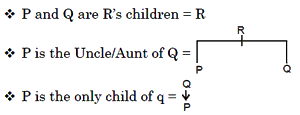
To draw a family tree, first of all identify the males and the females and then try to put each member at the appropriate position in the tree.
Example 1: Pointing to Lalit in the photograph, Rajan said, “His mother has only one grandchild whose mother is my sister.”How is Rajan related to Lalit ?
(a) Brother
(b) Brother-in-law
(c) Father-in-law
(d) Data inadequate
Solution: (b)
(a) Brother
(b) Brother-in-law
(c) Father-in-law
(d) Data inadequate
Solution: (b)
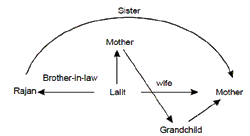
Example 2: Deepak said to Nitin, “The boy playing with the football is the younger of the two brothers of the daughter of my father’s wife.” How is the boy playing football related to Deepak?
(a) Cousin
(b) Brother
(c) Son
(d) Brother-in-law
Solution: (b)
(a) Cousin
(b) Brother
(c) Son
(d) Brother-in-law
Solution: (b)
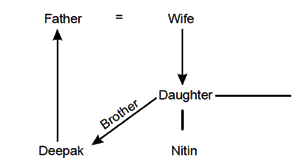
Example 3: B is the brother of A, S is the sister of B, E is the brother of D, D is the daughter of A, F is the father of S. Then, the uncle of E is
(a) A
(b) B
(c) F
(d) D
Solution: (b)
(a) A
(b) B
(c) F
(d) D
Solution: (b)
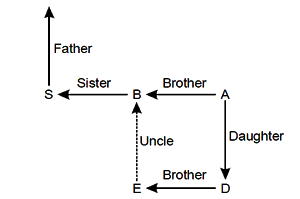
E and D are children of A and B is the brother of A. So, B is the uncle of E.
Example 4: Pointing to a man. On the stage “Rita said” He is the brother of daughter of the wife of my husband’. How is the man of stage related to Rita?
(a) Son
(b) Husband
(c) Cousin
(d) Nephew
Solution: (a)
(a) Son
(b) Husband
(c) Cousin
(d) Nephew
Solution: (a)
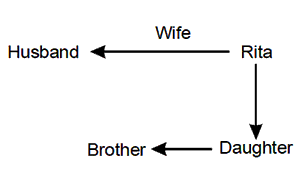
So, that person is the son of Rita.
Example 5: If “P * Q” indicates “P is the father of Q’; “P • Q” indicates `P is the sister of Q’; ‘P o Q” indicates ‘P is the brother of Q’; ‘P f Q” indicates ‘P is the mother of Q’; which of the following would represent ‘P is brotherin- law of Q” ?
(a) PoRfQ
(b) P *RfQ
(c) P•RfQ
(d) None of these
Example 5: If “P * Q” indicates “P is the father of Q’; “P • Q” indicates `P is the sister of Q’; ‘P o Q” indicates ‘P is the brother of Q’; ‘P f Q” indicates ‘P is the mother of Q’; which of the following would represent ‘P is brotherin- law of Q” ?
(a) PoRfQ
(b) P *RfQ
(c) P•RfQ
(d) None of these
Solution. (d) In order to represent the relationship of, “brother-in-law”, we need the symbol for either “husband” or “wife”, which is not given in the question. Hence, the required relationship cannot be represented by any of the combinations given. So, the answer is (d).
Example 6: Introducing a boy, a girl said, “ He is the only son of my mother’s mother”. How is the girl related to that boy ?
(a) Aunt
(b) Niece
(c) Sister
(d) Mother
Solution: (b)
(a) Aunt
(b) Niece
(c) Sister
(d) Mother
Solution: (b)
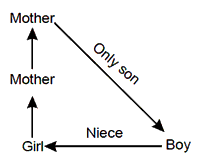
Directions (Q. Nos. 7 to 8) Read the following inforamation and answer the questions given below. P + Q mean P is the daughter of Q, P × Q means P is the son of Q and P – Q means P is the wife of Q.
Example 7: If A × B – D, which of the following is true ?
(a) D is wife of B
(b) A is daughter of B
(c) B is father of A
(d) D is father of A
Solution: (d)
(a) D is wife of B
(b) A is daughter of B
(c) B is father of A
(d) D is father of A
Solution: (d)
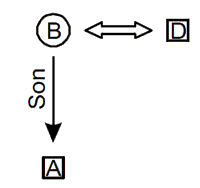
Example 8: If C – D × P – O, which of the following is not true?
(a) P is mother of D
(b) D is daughter of P
(c) C is wife of D
(d) 0 is husband of P
Solution: (b)
(a) P is mother of D
(b) D is daughter of P
(c) C is wife of D
(d) 0 is husband of P
Solution: (b)
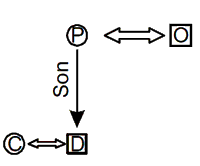
Example 9: R is the brother of G. Q is the sister of R. 0 is the brother of N. N is the daughter of G. L is the father of Q, who is the uncle of O ?
(a) R
(b) L
(c) G
(d) Q
Solution. (a) O is the brother of N who is the daughter of G. So, 0 is the son of G. R is the brother of G. So, R is the uncle of O. Hence, the answer is (a) R.
(a) R
(b) L
(c) G
(d) Q
Solution. (a) O is the brother of N who is the daughter of G. So, 0 is the son of G. R is the brother of G. So, R is the uncle of O. Hence, the answer is (a) R.
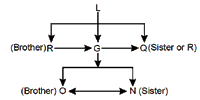
Example 10: If R * S means R is the wife of S, RT S means R is the father of S, R # S means R is the daughter of S and R -S means R is the brother of S, if P 0 # H # D ® Q, then how is D’ related to P’?
(a) Father
(b) Brother
(c) Mother-in-law
(d) Father-in-law
Solution. (d) P 0 # H # D ® Q means, P is the father of 0, 0 is the daughter of H, that means H is the mother of 0. (So P is the husband of H) and H is the daughter of D and D is the brother of Q, this means ‘D’ is the father of H. So, ‘D’ is the father-in-law of ‘P’.
(a) Father
(b) Brother
(c) Mother-in-law
(d) Father-in-law
Solution. (d) P 0 # H # D ® Q means, P is the father of 0, 0 is the daughter of H, that means H is the mother of 0. (So P is the husband of H) and H is the daughter of D and D is the brother of Q, this means ‘D’ is the father of H. So, ‘D’ is the father-in-law of ‘P’.
Example 11: If Y says that his mother is the only daughter of X’s mother, How is X’ related to Y?
(a) Uncle
(b) Brother
(c) Cousin
(d) Maternal uncle
Solution. (d) Assume Y’s mother be S, and X’s mother be T, As S is the only daughter of T. So, X is the son of T. The family tree can be draw as following.
(a) Uncle
(b) Brother
(c) Cousin
(d) Maternal uncle
Solution. (d) Assume Y’s mother be S, and X’s mother be T, As S is the only daughter of T. So, X is the son of T. The family tree can be draw as following.
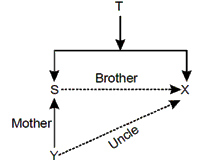
So, X is maternal uncle of Y.
Example 12: Pointing to Sagar in a photograph, Manjula said, “His brother’s father is the only son of my grandfather. “How is Manjula related to Sagar ?
(a) Aunt
(b) Sister
(c) Mother
(d) None of these
Solution. (b) Only son of Manjula’s grandfather. Manjula’s father and Sagar’s brother’s father-Sagar’s father. So, Manjula is Sagar’s sister.
(a) Aunt
(b) Sister
(c) Mother
(d) None of these
Solution. (b) Only son of Manjula’s grandfather. Manjula’s father and Sagar’s brother’s father-Sagar’s father. So, Manjula is Sagar’s sister.
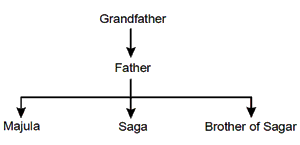
Hence, the answer is (b) Sister.
Example 13: Sia introduced Raghav as the son of the only daughter of the father of her uncle. How is Raghav related to Sia ?
(a) Brother
(b) Cousin
(c) Nephew
(d) Can’t be determined
Solution. (d) Only daughter of uncle’s father-uncle’s sister. But it is not clear that uncle’s sister is Sia’s mother.
(a) Brother
(b) Cousin
(c) Nephew
(d) Can’t be determined
Solution. (d) Only daughter of uncle’s father-uncle’s sister. But it is not clear that uncle’s sister is Sia’s mother.
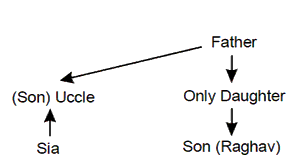
Hence, the answer is (d) cannot be determined.
Example 14: If P @ Q means P is the brother of Q, P D Q means P is the mother of Q and P f Q means P is the sister of Q, then which of the following would mean A is the uncle of B.
(a) ADP@B
(b) ADB@P
(c) A@PDB
(d) AfPDB
Solution. (c) A is the uncle of Bmeans A is the brother of themother of B. According to the given expressions. It must be A @PAB, so the answer is (c).
(a) ADP@B
(b) ADB@P
(c) A@PDB
(d) AfPDB
Solution. (c) A is the uncle of Bmeans A is the brother of themother of B. According to the given expressions. It must be A @PAB, so the answer is (c).
Example 15: Introducing a woman, Nisha said, ‘She is the daughter-in-law of the grandmother of my father’s only son.” How is the woman related to Nisha ?
(a) Grandmother
(b) Sister-in-law
(c) Sister
(d) Mother
Solution. (d) My father’s only son-my brother, grandmother of my brother-my grandmother and daughterin- law of my grandmother-my mother.
(a) Grandmother
(b) Sister-in-law
(c) Sister
(d) Mother
Solution. (d) My father’s only son-my brother, grandmother of my brother-my grandmother and daughterin- law of my grandmother-my mother.
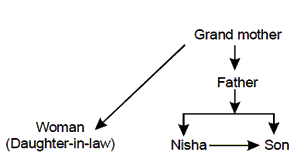
Hence, Nisha is the daughter of the woman. So, the answer is (d) Mother.
